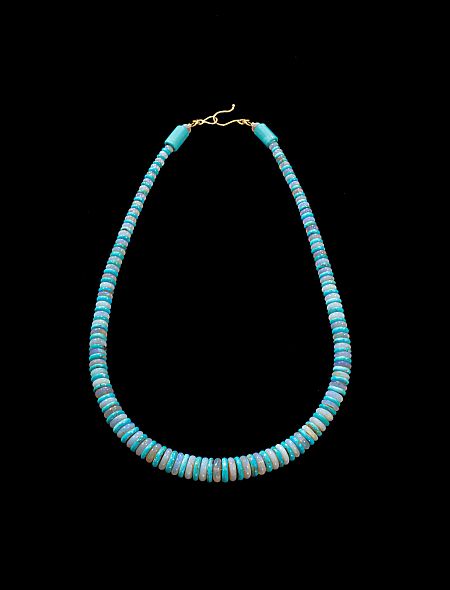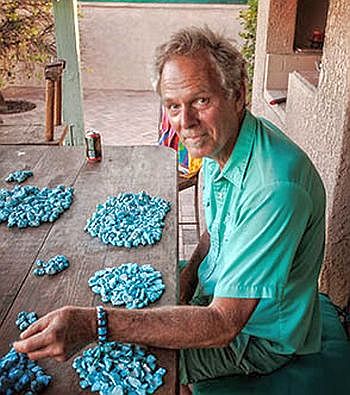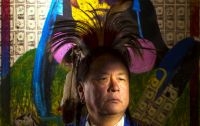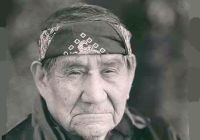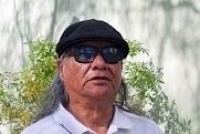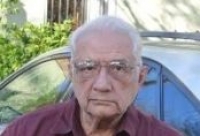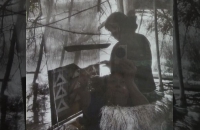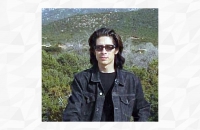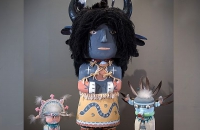J1546 Ethiopian Opal and Blue Gem turquoise by master lapidary Bruce Eckhardt. The 22" necklace has gold fasteners.
Australian opals are sedimentary in nature, forming in ancient sea beds, whereas Ethiopian opals originate from volcanic activity. All volcanic opal is called “hydrophane opal." The term hydrophane comes from the Greek words meaning “water-loving” and describes their ability to absorb water and change from opaque or semi-translucent to translucent or transparent. Sometimes this highlights the color play – others will just become transparent or opaque, with no color when hydrated.
The Blue Gem mine, which is no longer active, produced almost every shade of green and blue turquoise imaginable. The Blue Gem mine site is located near Battle Mountain. It produced a great variety of turquoise, from intense blue to deep green combinations with a hard, irregularly distributed matrix. The Battle Mountain or Blue Gem mine, which began production in 1934 yielded the most valuable Blue Gem turquoise because of its rich color and hardness.
Today, Bruce Eckhardt’s jewelry is a marriage of his love for the feel of stone and bright colors in his paintings. Eckhardt chooses rare, high-grade stones to create his stunning pieces, which highlight the inherent beauty of the materials he uses while offering customers a piece that feels utterly close to nature. He uses only the highest quality stones in his jewelry, and has an amazing eye for style and jewelry design.
Call for shipping
About the artist
Bruce Eckhardt
Bruce Eckhardt was raised in Arizona and lives in Santa Fe, New Mexico. His jewelry has been shown in the Southwest, and across the United States, as well as in collections in Europe, and Asia for over 30 years. He creates unmistakable jewelry and is known as a consummate lapidary artist, jewelry artist, and all around rock-hound.
One look at Bruce Eckhardt’s jewelry and you’d think he was born making beads. Yet for Bruce Eckhardt, his career in jewelry-making came about by way of his passion for painting.
Eckhardt studied with a Navajo painter at Prescott College in the early 70’s who created a student exchange program with the American Institute of Indian Arts IAIA in Santa Fe. As part of his student exchange, Eckhardt worked in the studio/classroom of Allan Houser – the well-known stone sculptor. During this time Eckhardt realized he loved the feel of stone—the density, resilience, and sense of eternity in the material, yet he still loved the bright colors of the paint he was used to working with.
Those stones of bright, vivid colors turned out to be gemstones. Over the years many other teachers including Charles Lavato from Santa Domingo Pueblo inspired Eckhardt; and taught Bruce how to roll beads. With the help of his talented teachers, Eckhardt developed and honed his own unique talent and signature style. He strives in his jewelry “to paint” with stone by capturing color and volume. It has been an evolution of many years work but ART is often like that, he says; “It becomes itself, in spite of itself.”
Today, Bruce Eckhardt’s jewelry is a marriage of his love for the feel of stone and bright colors in his paintings. Eckhardt chooses rare, high-grade stones to create his stunning pieces, which highlight the inherent beauty of the materials he uses while offering customers a piece that feels utterly close to nature. He uses only the highest quality stones in his jewelry, and has an amazing eye for style and jewelry design.
Eckhardt states: “Bigger beads create a stunning look.”
As a premier lapidary artist Eckhardt also has collaborated with other artists both local and world-wide. His work is analyzed and even critiqued as having been inspired byjewelryfrom the Merovingian era (or the 5th century AD). Always striving of a unique visual effect he alternates between maximizing the yield of each slab of stone to using the stone for the maximum visual effect.
His work has been collected by Rock Stars and Celebrities including; Madonna, Louis Malle, Candice Bergen, Joni Mitchell, Jenny Craig, ZZ Top and Santana.




